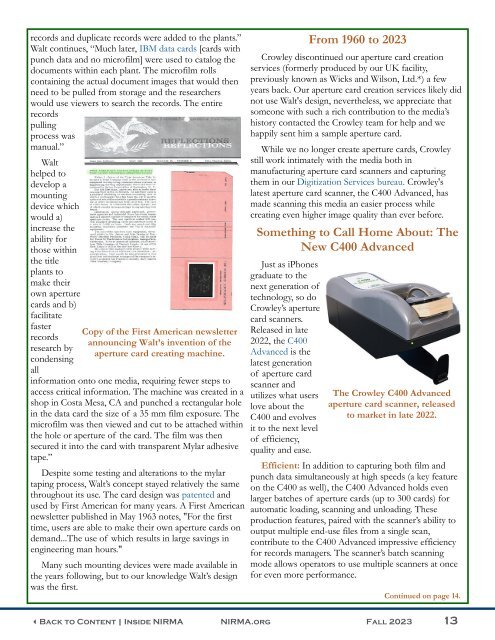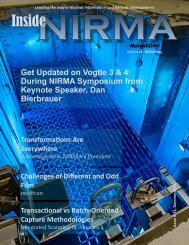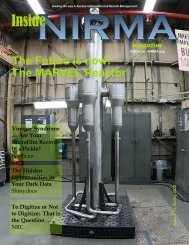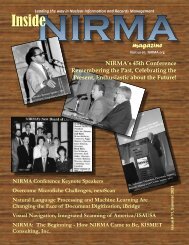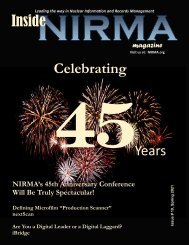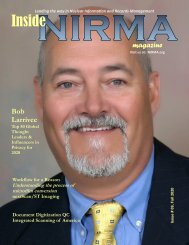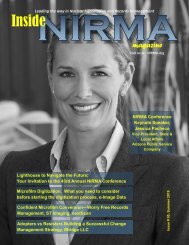Fall Inside NIRMA Issue
Create successful ePaper yourself
Turn your PDF publications into a flip-book with our unique Google optimized e-Paper software.
ecords and duplicate records were added to the plants.”<br />
Walt continues, “Much later, IBM data cards [cards with<br />
punch data and no microfilm] were used to catalog the<br />
documents within each plant. The microfilm rolls<br />
containing the actual document images that would then<br />
need to be pulled from storage and the researchers<br />
would use viewers to search the records. The entire<br />
records<br />
pulling<br />
process was<br />
manual.”<br />
Walt<br />
helped to<br />
develop a<br />
mounting<br />
device which<br />
would a)<br />
increase the<br />
ability for<br />
those within<br />
the title<br />
plants to<br />
make their<br />
own aperture<br />
cards and b)<br />
facilitate<br />
faster<br />
records<br />
research by<br />
condensing<br />
all<br />
Copy of the First American newsletter<br />
announcing Walt’s invention of the<br />
aperture card creating machine.<br />
information onto one media, requiring fewer steps to<br />
access critical information. The machine was created in a<br />
shop in Costa Mesa, CA and punched a rectangular hole<br />
in the data card the size of a 35 mm film exposure. The<br />
microfilm was then viewed and cut to be attached within<br />
the hole or aperture of the card. The film was then<br />
secured it into the card with transparent Mylar adhesive<br />
tape.”<br />
Despite some testing and alterations to the mylar<br />
taping process, Walt’s concept stayed relatively the same<br />
throughout its use. The card design was patented and<br />
used by First American for many years. A First American<br />
newsletter published in May 1963 notes, "For the first<br />
time, users are able to make their own aperture cards on<br />
demand...The use of which results in large savings in<br />
engineering man hours."<br />
Many such mounting devices were made available in<br />
the years following, but to our knowledge Walt’s design<br />
was the first.<br />
From 1960 to 2023<br />
Crowley discontinued our aperture card creation<br />
services (formerly produced by our UK facility,<br />
previously known as Wicks and Wilson, Ltd.*) a few<br />
years back. Our aperture card creation services likely did<br />
not use Walt's design, nevertheless, we appreciate that<br />
someone with such a rich contribution to the media’s<br />
history contacted the Crowley team for help and we<br />
happily sent him a sample aperture card.<br />
While we no longer create aperture cards, Crowley<br />
still work intimately with the media both in<br />
manufacturing aperture card scanners and capturing<br />
them in our Digitization Services bureau. Crowley's<br />
latest aperture card scanner, the C400 Advanced, has<br />
made scanning this media an easier process while<br />
creating even higher image quality than ever before.<br />
Something to Call Home About: The<br />
New C400 Advanced<br />
Just as iPhones<br />
graduate to the<br />
next generation of<br />
technology, so do<br />
Crowley’s aperture<br />
card scanners.<br />
Released in late<br />
2022, the C400<br />
Advanced is the<br />
latest generation<br />
of aperture card<br />
scanner and<br />
utilizes what users<br />
love about the<br />
C400 and evolves<br />
it to the next level<br />
of efficiency,<br />
quality and ease.<br />
The Crowley C400 Advanced<br />
aperture card scanner, released<br />
to market in late 2022.<br />
Efficient: In addition to capturing both film and<br />
punch data simultaneously at high speeds (a key feature<br />
on the C400 as well), the C400 Advanced holds even<br />
larger batches of aperture cards (up to 300 cards) for<br />
automatic loading, scanning and unloading. These<br />
production features, paired with the scanner’s ability to<br />
output multiple end-use files from a single scan,<br />
contribute to the C400 Advanced impressive efficiency<br />
for records managers. The scanner’s batch scanning<br />
mode allows operators to use multiple scanners at once<br />
for even more performance.<br />
Continued on page 14.<br />
Back to Content | <strong>Inside</strong> <strong>NIRMA</strong> <strong>NIRMA</strong>.org <strong>Fall</strong> 2023 13


